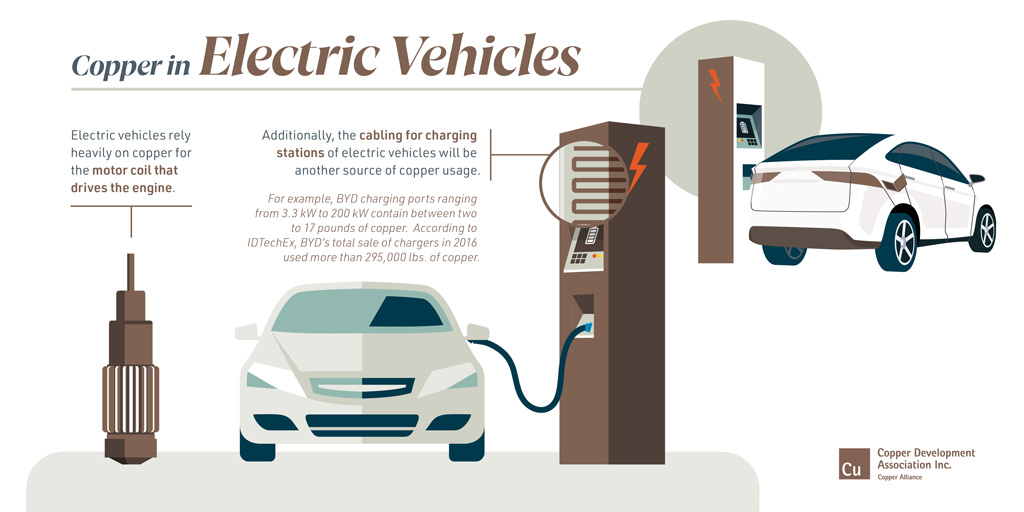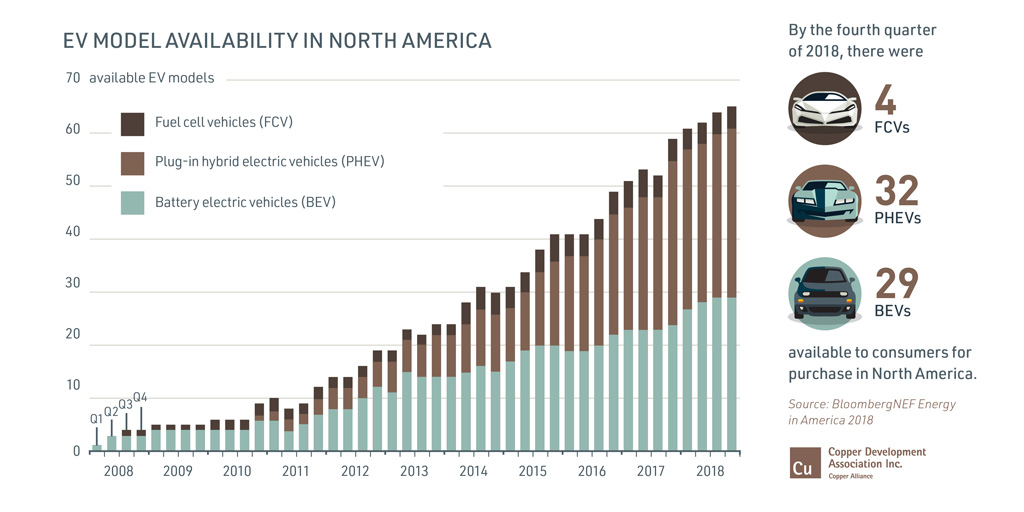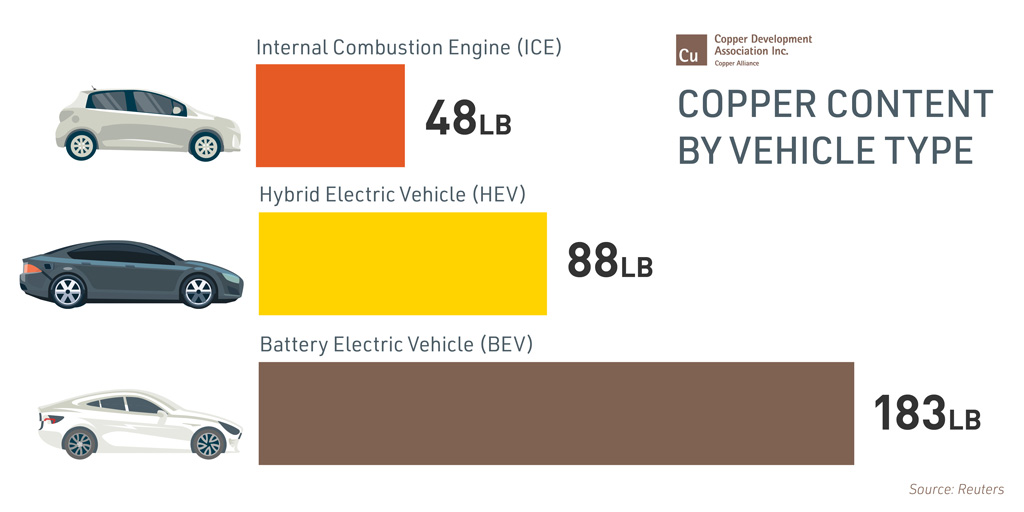
Copper is an essential material component of electric vehicles (EVs). It is used in the electric motors, batteries, inverters, wiring and in charging stations because of its durability, malleability, reliability and superior electrical conductivity.
Copper's Role in EVs
An EV can use between 85 and 183 pounds of copper and hybrid and electric buses can contain between 183 and 814 pounds.
Copper is also an indispensable component of the infrastructure needed to support electric vehicle charging. To power the EVs of both today and tomorrow, a network of five million charging ports will be needed within the next decade.
Benefits of Electrical Transportation
- Reduced Pollution
The transportation sector is now the largest source of carbon dioxide emissions in the U.S. The continued integration of EVs will help reduce this impact because they produce 54 percent less carbon dioxide emissions per mile than a conventional vehicle. - Cost Savings
EV batteries convert 59 to 62 percent of energy into vehicle movement while gas powered vehicles use 17 and 21 percent. EV drivers spend about $1.2 per gallon to charge, less than half the price of gasoline. The average operating cost of an EV is $485 annually compared to $1,117 for a conventional vehicle. - Economic Growth
According to the U.S. Department of Energy, in 2017, the U.S. imported 19 percent of the petroleum it used. Using Electric Vehicles can reduce our energy dependency abroad and support the U.S. economy through the generation of new jobs, particularly in skilled electrical trades.
EV Trends and Developments
- Increased Sales
Consumers are demonstrating strong interest in EVs and increasing demand. EVs accounted for only 1.3 percent of total vehicles sold in the U.S in 2017. By third quarter 2018, that had nearly doubled to 2.5 percent; hitting 3 percent by the fourth quarter.

- Proactive State Policies
States continue to raise clean energy goals with states like California, New Jersey, and New York setting a number of new, ambitious targets and regulations. However, Not all state-news is positive, as some made plans in 2018 to scale back net energy metering or renewable energy credit programs. - Support from Large Corporations
In 2019, companies like IKEA, HP and Unilever promised to ramp up integration of electric vehicles into their corporate fleets and to assist employees in transitioning to cleaner transportation.
Education
- Infographic-The Impact of Copper [PDF-1.7Kb] Copper is critical to our lives and communities today and will continue to be integral as we move toward sustainable energy resources in the future.
- Infographic - Copper’s Role in the Transition to Clean Energy [PDF - 1Mb]This new infographic illustrates Copper’s expanding role North America’s transition to clean power sources, from energy generation to storage and electric vehicles.
- Video - Copper's Role in EVs Electric vehicles (EVs) are a driving force in society's efforts to build a more sustainable future, but what's powering EVs? Watch and learn how copper is helping power North America's EV revolution!
- IEI Report - Plug-In Electrical Vehicle Forecast: 2016-2025 [PDF - 0.5Kb] A report by the Edison Electric Institute and the Institute for Electric Innovation (EEI/IEI) outlines a sales forecast for plug-in electric vehicles (PEV) and charging stations in the U.S. through 2025.
- Video - Could a carbon tax positively impact the transition to Electric Vehicles? The Atlantic Council’s David Livingston discusses the potential for a major infrastructure bill and how it could impact the transition to EVs at CDA’s 2018 Electric Vehicle Summit.
- Video - What are the electric vehicle game changers for the transportation sector? Lisa Jerram from the American Public Transportation Association talks about the potential opportunities and game changers that electrification will bring to the transportation sector at CDA’s 2018 Electric Vehicle Summit.
- Video - Will automakers evolve into energy providers? AUDI’s Chris Michelbacher discusses the industry shift that could potentially turn automakers into energy providers at CDA’s 2018 Electric Vehicle Summit.
- Video - What are the emerging best practices and standards for charging stations? Steve Griffith from The National Electrical Manufacturers Association highlights some emerging best practices for charging stations at CDA’s 2018 Electric Vehicle Summit.
- Video - What's next for AC and DC charging infrastructure? Electrify America’s Wayne Killen addresses what’s next for AC and DC charging infrastructures at CDA’s 2018 Electric Vehicle Summit.
Case Studies
- The Road to Sustainable Mobility is Paved with Copper [PDF - 2Mb]
This case study examines the development of the electric vehicle industry and outlines copper’s role in electric vehicle technology and charging infrastructure.
Archives
-

- On the Road with Ricardo and Cars That Think
Global engineering provider Ricardo is behind vehicles that help businesses grow, improve air quality at airports, and even drive you to work while you relax and read the morning paper.
-

- Copper Delivers Energy, Power and Speed
This video shows how a copper rotor can improve the performance of electric and hybrid-electric vehicles with examples of companies using this technology.
-

- Copper Improves the Performance of Induction Motors
As automotive manufacturers view their options for reducing fuel consumption and emissions, electrical propulsion becomes more attractive. Historically, internal permanent magnet (IPM) motors have been a popular motor design.
-

- The Value of Using Cast Copper Induction Motors in Hybrid and Plug-in Electric Vehicles
The Copper Development Association recommends the copper induction motor over the permanent magnet motor when choosing an electric motor for a Hybrid (HEV) or Plug-in Hybrid (PHEV) electric vehicle.
-

- Making a Good Thing Better
While major automakers have received lots of attention for their hybrid and electric vehicles, a couple of Michigan companies have quietly achieved success selling after-market systems for passenger cars and commercial vehicles.
-

- Copper Is on Board as 2011 Detroit Auto Show Electrifies Visitors
The 2011 North American International Auto Show in Detroit was electrifying for copper stakeholders. Get the latest from automotive heads, show visitors and the media.
-

- Automakers Face Challenges on the Road to Electrification
There seem to be as many opinions on the electric evolution currently underway in the automotive industry as there are experts. What seems clear is that, ultimately, the move toward vehicle electrification is going to have a positive impact on the copper industry.
-

- FEV: Putting Electrification to the Test
Gary Rogers, Chief Executive Officer and President of FEV, Inc., talks about the company's beginnings and its unique role in the evolution of the automotive industry toward vehicle electrification. Several key projects developed in the company's North American Technical Center are highlighted.
-

- AVL and Electrification: A Discussion With Jerry Klarr
Jerry Klarr, Director of Hybrid Programs at AVL, recently took time out of his schedule to discuss the company's role in vehicle electrification and the important role of copper in new automotive technologies.
-

- Copper Applications in Electrical: Electric Vehicles
Electric and hybrid electric vehicles have reached a new level of development with introductions by Chrysler, Ford, General Motors, Honda and Toyota. Because an electric motor is used as the primary propulsion source, these vehicles will have a much higher copper content than a conventional vehicle which currently averages about 55 pounds of copper and copper alloys.

